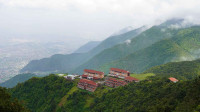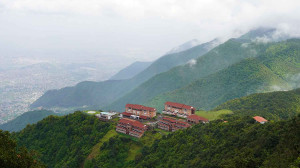Money
2020 was the worst year for tourism since 1986
The industry has pinned its hopes on the vaccine but is now worried about political instability with the House dissolution and polls announced for this spring.
Sangam Prasain
Visit Nepal 3.0 hoped to host 2 million tourists in 2020 but it ended up becoming the worst year for tourism since 1986.
The Covid-19 pandemic crisis resulted in 80.78 percent drop in tourist arrivals of the previous year making it the worst year-on-year drop in terms of arrivals number since Nepal opened for the outside world in the 1950s.
In 1955 world-renowned Thomas Cook and Sons brought a group of 60 tourists to Nepal, who were officially recognized as foreign tourists. Nepal started keeping records of foreign tourists since 1962.
According to the statistics of the Department of Immigration, only 230,085 foreign tourists visited Nepal last year, a figure similar to that of 1986.
And most of them came before the country restricted the arrival of tourists on March 20, as fewer 15,000 visited Nepal between April and December.
On March 12, 2020, the government decided to stop issuing on-arrival tourist visas to nationals of all countries besides cancelling spring mountaineering expeditions including those to Everest. The decision came a day after the World Health Organisation declared the Covid-19 outbreak a pandemic, and urged countries to take precautionary measures.
From October 17, Nepal opened the door a crack for trekkers and mountaineers, nearly seven months after the country imposed a complete lockdown.
The government, in the first week of December, allowed all tourists to enter the country by air. But even now, on arrival visas, a facility to attract visitors, are not issued easily.
The fall in tourist numbers has shaved off 90 percent of an annual Rs75 billion foreign exchange earnings in recent years from the tourism industry.
Tens of thousands have lost their jobs.
The foreign exchange earnings primarily reflect the economic activity generated by industries such as hotels, travel agencies, airlines and other passenger transportation services, excluding commuter services.
It also includes, for example, the activities of the restaurant and leisure industries directly supported by tourists.
Mountaineering is one of the key foreign exchange generating sources. In 2019, the government earned $5.07 million or Rs608 million in royalties from the issuance of climbing permits. Out of the total revenue, Everest accounted for $4.05 million or Rs486 million.
While news of the availability of vaccines had made tourism entrepreneurs cautiously optimistic, the political instability has become a new cause of concern.
“The news of a potential vaccine does hold promise for travel in 2021, but again there is a political instability,” said Naresh Bhattarai, a Pokhara-based hotel entrepreneur.
The virus brought the world to a standstill, and tourism has been the worst affected of all.
“The beleaguered industry is again into uncertainty with the announcement of the general election this spring. We don’t have much expectation in 2021,” Bhattarai, the owner of Mount Kailash Resort in the Lakeside of Pokhara, told the Post. “Without an improvement in tourist movement, either domestic or international, and given the little support from the government, the future of the hospitality industry is at stake.”
Nepal’s tourism sector generated Rs240.7 billion in revenue and supported more than 1.05 million jobs directly and indirectly in 2018, according to the annual World Travel and Tourism Council research report. The London-based organisation said that travel and tourism's total contribution to the country’s gross domestic product stood at 7.9 percent.
The tourist arrivals figure for 2020 is far worse than the downturn during the Maoist insurgency between 1996 and 2006 and the 2015 earthquakes combined.
Tourist arrival to Nepal dropped to 275,468 individuals in 2002, the peak of the conflict, from 491,504 arrivals in 1999.
It was only in 2007 that Nepal, for the first time, hosted a half a million tourists.
The industry suffered once again following the 2015 earthquake that killed nearly 9,000 people. That time, arrivals plunged by 32 percent to 538,970. Arrivals crossed the coveted one-million mark for the first time in 2018 with 1.17 million foreign tourists streaming into the country.
“Though news of a potential vaccine does hold promise for travel in 2021, given the multiple factors like the political situation, the rebound in international travel will take time,” said Dhananjay Regmi, chief executive officer of Nepal Tourism Board, the country’s tourism promotional body.
“Our best-case scenario is that domestic tourism will start to improve after the winter in March, while foreign visitors should come in around autumn,” he said.
Since the end of July, tourism entrepreneurs have turned to domestic visitors to stay afloat, reopening mountains and trekking trails, jungle safari and various landmarks to local travellers.
Deepak Raj Joshi, coordinator of the Tourism Recovery Task Force, a tourism think tank formed to suggest plans for the recovery of the industry, said that domestic demand is expected to recover faster than international demand and it would, to some extent, boost the industry’s confidence.
Hotels and restaurants have been struggling to survive with their guest rooms remaining empty for the last nine months and multiple hotels have shuttered.
The iconic Annapurna Hotel on Durbar Marg is closing its doors for an indefinite period due to a severe loss of revenue as the coronavirus snuffed out the tourism industry.
Established in 1965, the Annapurna is one of Nepal’s oldest five-star properties. Its closure highlights the deep trouble in the tourism industry, insiders said.
All hopes now are on timely availability of the vaccine.
“I’m very optimistic that once the vaccines get distributed, people’s perceptions around travel are going to change. They will travel,” said Joshi, a former chief of Nepal Tourism Board.
“As per our initial survey, there is a sign of recovery by the second quarter of 2021 but the government should play an active role to remove travel hassles. Based on previous crises, leisure travel is expected to recover quicker, particularly travel to visit friends and relatives, rather than business travel.”




 13.98°C Kathmandu
13.98°C Kathmandu















